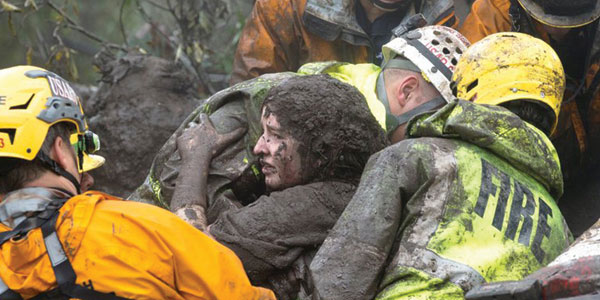
Compiled From Media Reports
Disaster among several headline-grabbing natural phenomenaAnother natural disaster has hit Southern California.
At press time, Ventura County in Southern California was dealing with rain-induced flooding and mudslides. As of Wednesday afternoon (Jan. 10), multiple news agencies were reporting that 15 people had died and that rescue crews were continuing to search for victims.
“You couldn’t help but be amazed at the intensity of the storm and the result of the mudslide and the water that cascaded down the hills as a result,” Santa Barbara County Sheriff Bill Brown told Gayle King Wednesday morning on “CBS This Morning.”
The flooding and mudslides come about a month after a series of wildfires broke out in Southern California that caused mass evacuations.
Southern California wasn’t the only area trying to recover from a major natural disaster at press time. Multiple news agencies were reporting that recent volcanic eruptions had prompted a mass evacuation from Kadovar, an island that’s part of Papua New Guinea. Papua New Guinea officials were estimating that 2,000 residents of the island would need to be relocated, the Australian Broadcasting Corp. reported Wednesday.
On the other hand, another natural phenomenon attracted headlines because it didn’t wreak havoc: Late Tuesday night (Jan. 9), a 7.6-magntitude earthquake rumbled in the Caribbean Sea.
According to The Associated Press (AP), the earthquake’s epicenter was near the Honduran coast. The AP also reported that “there were no early reports of serious damage or casualties on land,” even though shaking from the earthquake was felt in many parts of the Central American country. In addition, the news agency reported there had been concern of the earthquake creating a tsunami in the Caribbean Sea, but that one hadn’t developed.
___________________________________________________________________________________________________
Sur de California recuperándose de deslizamientos de tierra e inundaciones
Desastre entre varios fenómenos naturales que acaparan los titulares
Otro desastre natural ha afectado al sur de California.
Al cierre de esta edición, el condado de Ventura en el sur de California estaba lidiando con inundaciones inducidas por la lluvia y deslizamientos de tierra. A partir del miércoles por la tarde (10 de enero), diversos medios de comunicación informaron que 15 personas habían muerto y que los equipos de rescate seguían buscando víctimas.
«No se puede evitar sorprenderse por la intensidad de la tormenta y el resultado del deslizamiento de lodo y el agua que cayó en cascada como resultado», indicó el alguacil del condado de Santa Bárbara, Bill Brown, a Gayle King el miércoles por la mañana en «CBS This Morning”.
Las inundaciones y los deslizamientos de tierra se producen aproximadamente un mes después de que una serie de incendios forestales estallaran en el sur de California causando evacuaciones masivas.
Al cierre de esta edición, el sur de California no era la única área que intentaba recuperarse de un gran desastre.
Múltiples medios de comunicación informaron que recientes erupciones volcánicas habían provocado la evacuación masiva de Kadovar, una isla que es parte de Papúa Nueva Guinea. Funcionarios de Papúa Nueva Guinea estimaron que 2,000 residentes de la isla necesitarían ser reubicados, informó el miércoles la Australian Broadcasting Corp.
Por otro lado, otro fenómeno natural atrajo titulares al no causar estragos: el martes por la noche (9 de enero), un terremoto de 7.6 grados de magnitud rugió en el Mar Caribe.
Según The Associated Press (AP), el epicentro del terremoto fue cerca de la costa hondureña. La AP también informó que “no hubo informes de daños graves o víctimas en la tierra”, a pesar de que la sacudida del terremoto se sintió en muchas partes del país centroamericano. Además, la agencia de noticias informó que se había tenido preocupación de que el terremoto creara un tsunami en el Mar Caribe, pero que este no se había desarrollado.










